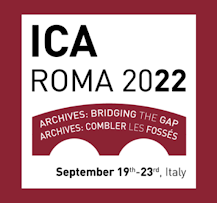29th
November 2022
Location: ‘The Bridge
Room’, Hardiman Building, University of Galway
2pm Welcome and
Introductions:
Barry Houlihan, Archivist, Library Archives.
John Cox, University Librarian
2.15 - 3.15pm: Panel
1: ‘A Theatre of Ideas’ - Pan Pan and Contemporary Irish Drama
Ian Walsh - Out of the dark: Pan Pan’s Staging of Beckett’s
Radio Plays, All that Fall and Embers.
Charlotte McIvor: ""Pan Pan's Conceptual Theatre of Rigour and International Lineages of Resonance."
Emer McHugh: ‘Playing [with] Shakespeare, Playing the Dane’.
Chair: Finian O’Gorman
3.15pm - 4pm: Pan Pan
and the Archive - "Noise and People, People and Noise"
Barry Houlihan
Aafke
Van Pelt
Break: 4pm – 4.15pm
4.15 - 5pm Gavin
Quinn and Aedín Cosgrove in conversation, moderated by Patrick Lonergan
5pm Launch of Pan Pan
Archive and Digital Exhibition
Welcome and Introductions: Dan Carey, Director, Moore Institute.
Launched by Willie White, Artistic Director, Dublin Theatre Festival.
Refreshments provided.
 |
Andrew Bennett and Judith Roddy, in Everyone is King Lear in Their Own Home,
Pan Pan Theatre Company, 2012. Photograph (c) Ros Kavanagh. |
Pan Pan Theatre
Company Archive and Digital Exhibition launched at University of Galway Library
The archive of the award-winning Pan Pan Theatre Company has
been donated to the University of Galway Library Archives. Established in 1993
by Gavin Quinn and Aedín Cosgrove, Pan Pan Theatre Company have established
international recognition as one of Ireland’s premiere theatre companies,
touring throughout Ireland, Europe, the United States and from China to New
Zealand. The archive is fully catalogued and available to researchers at
University of Galway Library. A new digital online exhibition will share the
Pan Pan archive with a global audience.
The Pan Pan archive consists of annotated scripts,
production notebooks, photographs, designs, programmes, posters, and a vast
collection of digital show recordings, spanning more than fifty boxes of
materials from the last thirty years. The papers document the early years and
development of the company led by Quinn and Cosgrove, who have directed and
designed the majority of Pan Pan productions. Pan Pan were established in 1993
as “Ireland’s first deaf ensemble”. Pan Pan produced work for and with deaf
practitioners and audiences, creating a new space of accessibility for Irish
theatre in the mid- and late-1990s. New original works by Pan Pan at this time Tailors Requiem (1996), Cartoon (1998), and Standoffish (2000).
In later years Pan Pan adapted Irish and European classics
in new and innovate productions. Oedipus
Loves You by Simon Doyle and Gavin Quinn
(2006), which starred Ruth Negga, toured to international acclaim. The Crumb Trail by Gina Moxley (20009)
revisited the form of the fairy tale for a modern technology-driven society.
Pan Pan engaged with the works of Samuel Beckett and William Shakespeare across
a number of productions. Pan Pan produced Beckett’s radio plays, All That Fall in 2011, and Embers in 2013, and also Beckett’s Quad (2013) and Endgame (2019). Shakespeare’s works were explored in Mac-beth 7 (2004) and The Rehearsal: Playing the Dane (2010),
a reworking of Hamlet. In 2006, Pan
Pan staged an all-Chinese cast production of J.M. Synge’s The Playboy of the Western World in Shanghai, translated into
Mandarin, setting the production in a contemporary hairdresser’s salon.
Pan Pan are today producing new works and regularly touring
nationally and internationally. The recipients of many international awards as
well as Irish Times Irish Theatre
Awards, the Pan Pan archive documents a company that has always sought to
innovate, reinterpret, and connect Irish theatre and culture to the worldwide
audience.
Dr. Barry Houlihan, Archivist, University of Galway,
commented that “working on the Pan Pan archive and cataloguing its vast array
of materials is a reminder of the immense contribution that Pan Pan have made
to contemporary Irish drama in Ireland and internationally. The archive will be
in an immersive and fascinating resource for anyone interesting in the company
and modern Irish theatre and culture.”
Gavin Quinn and Aedín Cosgrove, co-founders of Pan Pan
Theatre Company added: “It's an amazing opportunity that University of Galway
has given Pan Pan to make our work available in this archive, we are blown away
by the dedication and curatorial excellence of the Archive team. We are
delighted that our little contribution to the theatre scene in Ireland will be
preserved."
Dr. Charlotte McIvor, Head of Drama, Theatre, and
Performance at University of Galway commented: “The acquisition of the Pan Pan
archive gives us another opportunity to bring together history and practice in
our Drama and Theatre Studies classrooms and across the School of English and
Creative Arts. Pan Pan have always been
at the vanguard of moving Irish theatre forward as a landscape since their founding,
and we are now delighted to be partnering with them to bring the transformative
story of their history and their future directly to our students.”
The Pan Pan archive digital exhibition, curated by Aafke Van
Pelt with Eimhin Joyce and Barry Houlihan, includes over four hundred digital
objects from across the Pan Pan archive, all freely accessible online via the
University of Galway Library Digital Repository.
John Cox, University Librarian, University of Galway adds
that, “We are delighted to have secured the archive of such an
innovative company as Pan Pan. This archive is a tremendous collection in its
own right and complements our archival coverage of other Irish theatre
companies, including the digitised archives of the Abbey and Gate Theatres and
others in paper format such as those of the Druid, Lyric and Taibhdhearc.”
The
Pan Pan archive and digital exhibition will be launched at an event in
University of Galway by Willie White, Director of the Dublin Theatre Festival
on 29th November. All are welcome to attend.
Link to Digital
Exhibition: https://exhibitions.library.nuigalway.ie/s/panpan/page/introduction































